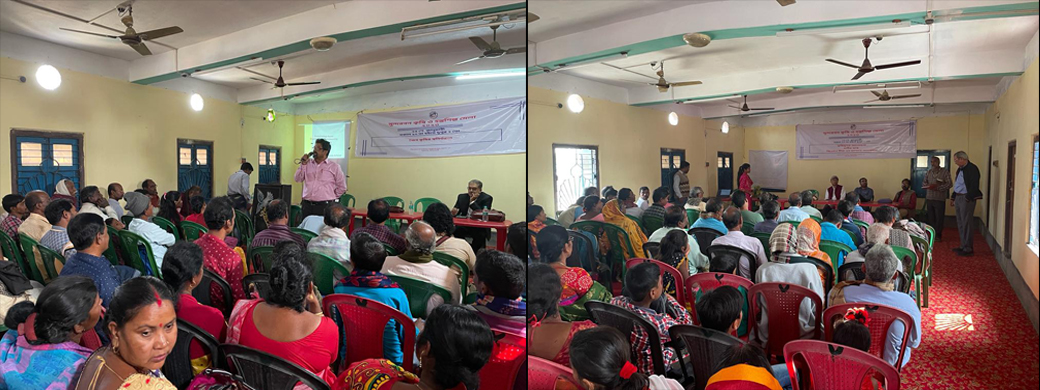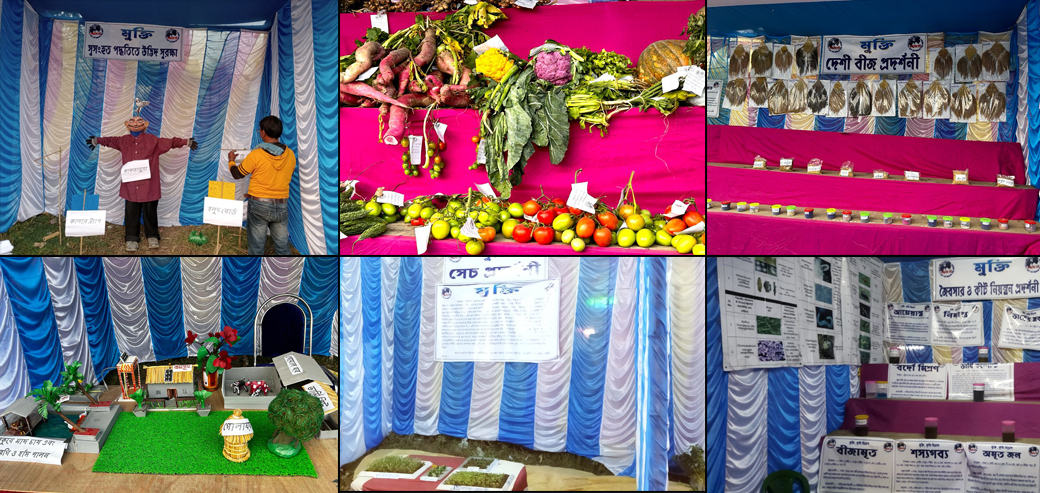

Agricultural Stalls at “Sundarban Agriculture and Handicraft Fair 2023”
In the 5-day mega agriculture exhibition at the Vivekananda fairground, Mukti organized 12 stalls; 9 were from Mukti SAM (Sustainable Agricultural Movement) farmers and 3 from the organization “Seeds”.In addition to the stalls, 5 seminars were conducted for the benefit of Mukti-associated progressive farmers. Around 550 farmers from Nagendrapur and Kankandigi GP participated in the event and took advantage of these training sessions. On 22nd January, 10 SAM farmers who practice exclusively organic farming were felicitated with certificates and mementos for their achievements in sustainable farming.

The event was not just a farmer’s conclave, but a big training camp, in which training was imparted on three days from 10 am to 1 pm in different sessions covering advanced farming, use of technology in farming, shifting towards remunerative crops, use of biofertilizers and developed technology, production of paddy with less water, improvement of yields of the crops of pulses and oilseeds, and expansion of areas for horticulture, etc.
| Date | Speaker | Designation/ Affiliation | Subject | Number of farmer attendees |
| 23rd Jan | Mr. SankardebGayen | ADA (Additional Director of Agriculture), Canning | Discussion on soil health | 160 |
| Mr. Anshuman Das | Are GMO seeds beneficial or harmful? | Food and Agriculture Workers, Welthungerhilfe | ||
| 24th Jan | Dr.Avijit Ghosal | Treating plant diseases organically | ADA of SMS plant protection (KVK) | 145 |
| Dr. Pratap Mukhopadhay | Fish and animal husbandry | Ex-scientist of ICAR (Indian Council of Agricultural Research) | ||
| 25th Jan | Dr.KrishnenduAchariya | Self-reliance of organic farmers and microorganisms | Professor and Head of the Department of Botany, University of Calcutta | 195 |
| 3 days | 5 seminars | 500 |
Mukti is hopeful that the training will benefit the farmers immensely and they will be able to convert their farming into advanced farming.

11 stalls were set up to showcase the activities of Mukti’s organic farmers.
| Stall number | Stall Exhibit |
| 1 | 25 varieties of organic vegetables (the biggest and most beautiful) were exhibited. First and second place holders of each variety were given agricultural equipment. |
| 2 | This stall was of integrated framing. Through a table model, farmers showcased what an Ideal agricultural farm will look like. |
| 3 | The third stall was the collection of salt-tolerant and native paddy seeds. 70 types of paddy seeds and different types of vegetable seeds were exhibited. |
| 4 | In this stall, visitors were introduced to organic manure such as Amritpani, Ghonojibammrit, vermicompost, etc. Visitors were shown the making, function, and use of these manures. |
| 5 | The fifth stall was on pest management. Making of tree traps, yellow boards, color traps and scarecrows was shown as easy means of pest management through poison-free and chemical-free means. |
| 6 | Straw mulching and poly mulching methods were demonstrated in the sixth stall. Mulching is the technique of covering the soil surface around the plants with an organic or synthetic mulch to create favorable conditions for plant growth and proficient crop production |
| 7 | One stall was decorated as the SAM office. Various leaflets flex etc. were distributed to the visitors to describe the activities of SAM. |
| 8 | The stall was set up to introduce visitors to the famous honey of the Sundarbans. The stall displayed different types of honey such as mustard honey, lotus honey, litchi honey and many other flower honey. |
| 9 | Through the landless farming technique, it was shown how landless indigenous farmers can grow nutritious vegetables with minimal space and cost. |
Visitors visited the stalls and gained concise knowledge of organic farming.
Project Activities
- A village for independent and enterprising women (A VIEW) (5)
- About Mukti (4)
- Accreditation (14)
- AGM (63)
- Agriculture Reforms (123)
- Ambulance Service (2)
- Amplifying Community Voices (67)
- Awards (15)
- Awareness and Empowerment (133)
- Awareness drives (57)
- Bio-Village-Kankandighi (10)
- Careers (14)
- Chick Rearing Programme for Marginalised Women (16)
- CHILD (18)
- Climate Resilience River Embankment (46)
- Covid-19 (74)
- Cultural Shows (7)
- Cyclone Aila (13)
- Cyclone Amphan (44)
- Cyclone Bulbul (30)
- Cyclone Dana (3)
- Cyclone Remal (12)
- Cyclone Response & Recovery (90)
- Cyclone Tolerant Houses (15)
- Cyclone Yaas (57)
- Disaster Recovery (264)
- Editorial (55)
- Editorial by Abir Biswas (1)
- Editorial by Amit Kumar Dey (2)
- Editorial by Ananya Chatterjee (3)
- Editorial by Ankita Kothiyal (3)
- Editorial by Debabrata Halder (1)
- Editorial by Dr. Alokananda Ghosh Sengupta (2)
- Editorial by Kasturi Bakshi (1)
- Editorial by Monami Mitra (1)
- Editorial by Nandita (3)
- Editorial by Pampa Karmakar (1)
- Editorial by Pranay Patra (1)
- Editorial by Prof. Pradeep Ray (1)
- Editorial by Ranitendranath Tagore (1)
- Editorial by Sankar Halder (14)
- Editorial by Satyajit Ray (7)
- Editorial by Sohini Mehta (1)
- Editorial by Sonamon Basu (3)
- Editorial by Soumitra Bose (2)
- Editorial by Subhankar Basu (1)
- Editorial by Supriyo Banerjee (3)
- Editorial by Ujjwal Maity (2)
- Education and Enrichment (409)
- Environment and Resilience (127)
- Featured Activities (24)
- Gram Clinic (9)
- Health Water & Sanitation (95)
- HOPE (10)
- Impact Stories List (109)
- Integrated Development (210)
- International Management Institute (IMI) (2)
- Jal hi Kal (6)
- Kitchen Gardening (16)
- Livelihood & Enablement (218)
- MCDF (119)
- Medical Camp (44)
- MIT (8)
- MKSS (49)
- MSS (142)
- Mukti Academia (5)
- Mukti Academy (2)
- Mukti Craft (17)
- Mukti Cultural (2)
- Mukti Employment Exchange (MEE) (9)
- Mukti Fresh (15)
- Mukti Gram - Egra (11)
- Mukti Gram - Purbashridharpur (170)
- Mukti Green Defense in Sundarbans (11)
- Mukti Yoga (12)
- Mukto Dhara (2)
- Northumbria University (2)
- Obituary (6)
- Observance Days Celebration (53)
- Organic Farming & Training Support (45)
- Pond Rejuvenation (20)
- Prerana (1)
- Prerna (4)
- Projects For Mukti Wide (7)
- Queen Mary University of London (1)
- Rights and Special Needs (113)
- Run for Cause (13)
- Run4SafeFood (7)
- SDF (6)
- Shahoshini (9)
- Skill & Enterprise Development (21)
- Smart lab (5)
- Social Stock Exchange (2)
- Social Workers' Convention (1)
- Sundarbans Green (SUN-G) (15)
- Sunderban development fair project (4)
- Surya (12)
- Sustainable Agriculture Movement (62)
- SWAS-2-0 (18)
- Swastha Shongini (32)
- Swavalamban Accelerator in Sundarbans (SWAS) (21)
- Tour for Cause (45)
- TSS (195)
- UDAAN (7)
- Uncategorized (99)
- University of Calcutta (1)
- Value Education (12)
- Valued Partners (3)
- Vocational Trainings (15)
- VOICE (14)